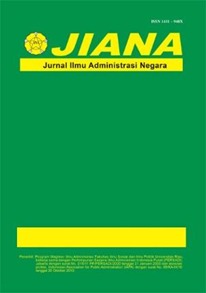KOMITMEN ORGANISASI, BUDAYA ORGANISASI, DAN KINERJA PEGAWAI
DOI:
https://doi.org/10.46730/jiana.v18i1.7909Kata Kunci:
Organizational Commitment, Organizational Culture, and Employee PerformanceAbstrak
Organizational Commitment, Organizational Culture, and Employee Performance. This study aims to determine the effect of organizational commitment and organizational culture on employee performance in the Regional Civil Service Office of Riau Province. All variables in this study were measured using a Likert scale. This research was conducted at the Regional Civil Service Office of Riau Province by using its employees as respondents. The total number of respondents sampled in the study were 66 people. The data analysis method used to test hypotheses is multiple regression analysis using the SPSS version 23 program. Partial regression test (t test) shows that the organizational commitment and organizational culture variables have an influence on employee performance, the magnitude of the effect caused (R2) by these two variables together on the dependent variable 62%, while the remaining 38% is influenced by variables other variables not examined in this study.
Referensi
Ghozali, Imam. 2016. Aplikasi Analisis Multivariate dengan Program IBM SPSS 23. Penerbit Universitas Diponegoro. Semarang.
Mansyur, Ahmad. Trisnawati, Tina. 2010. Metode Penelitian dan Teknik Penulisan Laporan Karya Ilmiah. Bandung.
Robbins, Stephen P. 2012. Perilaku Organisasi Edisi Kesepuluh. PT Indeks Kelompok Gramedia. Jakarta.
Sudjarwo dan Basrowi. 2012. Manajemen Penelitian Sosial. Mandar Maju. Bandung.
Sugiyono. 2012. Metode Penelitian Kuantitatif Kualitatif dan R&D. Alfabeta. Bandung.
Unduhan
Diterbitkan
Cara Mengutip
Terbitan
Bagian
Lisensi
The copyright of the received article shall be assigned to the journal as the publisher of the journal. The intended copyright includes the right to publish the article in various forms (including reprints). The journal maintains the publishing rights to the published articles.
Authors are permitted to disseminate published articles by sharing the link/DOI of the article at the journal. Authors are allowed to use their articles for any legal purposes deemed necessary without written permission from the journal with an acknowledgment of initial publication to this journal.

Jurnal Ilmu Administrasi Publik is licensed under a Creative Commons Attribution-NonCommercial-ShareAlike 4.0 International License.




